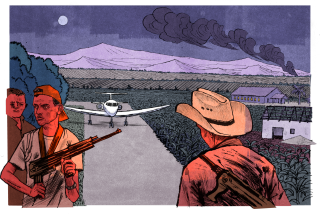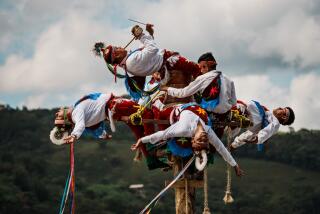Great <i> Guapote</i> : Angler Uncovers Unique Fishing Experience at Ancient Costa Rican Volcano
- Share via
SAN JOSE, Costa Rica — It’s a pilgrimage Bob Hohl makes as often as possible.
It begins in the morning at his office on the outskirts of this busy little city and takes him 42 miles, through rolling hills covered with coffee plants and into the lush Costa Rican rain forest.
It culminates deep inside an ancient volcano near the small agricultural town of San Miguel.
Standing on the rim of the long-dormant volcano, believed to have last been active about 3,000 years ago, and staring into the crater on his most recent journey, Hohl, despite many previous trips here, can’t help but marvel at its magnificence: the verdant jungle flourishing around its inner walls, and the shimmering little lake that thousands of years ago formed in its basin.
“Isn’t that something?” Hohl says.
It is. But it is not so much the beauty as the beast within the lake that brings Hohl to its overgrown shores several times a year--a mean little fish called a guapote .
“I’m after the world record,” Hohl says, a look of determination on his bespectacled face. “And I’ve come very close to catching it--twice.”
The world record is an 11 1/2-pound guapote caught by Hohl’s friend, Ray Baum, in 1986. It was at Lago Hule , as the lake is called, named after the rubber trees that used to grow in the area. (The record is listed as coming from another Costa Rican water, San Miguel de Sarapiqui, because Baum wanted to keep Lago Hule a secret).
Hohl also claims to have caught an 11 1/2-pound guapote , on his first visit to Hule in 1985. “We didn’t know they (the International Game Fish Assn.) even had a category for this fish back then,” Hohl says. “We never applied, but I do have a picture of the fish hanging on the scale.”
Since then, he has hauled in a pair of perfect bookend guapote , at 11 pounds 3 ounces apiece.
But until he catches one for the books, the 40-something manufacturer of electronic components, who looks more like an accountant than a fisherman, will visit the little lake in the volcano every chance he gets.
*
Guapote is Spanish for “handsome one” or “good-looking,” which is strange considering that although they are capable of flashing beautiful colors underwater, large adults have ugly lips and large males develop tumorous-looking bumps the size of baseballs on their heads.
Handsome or not, though, the guapote has developed a following in these parts much like the largemouth bass has in the United States. The fishing techniques used, with spinnerbaits and other bass-type lures, are nearly identical.
Two characteristics differentiate the two, however. One are the mouths. The guapote’s is full of teeth. “Sharp, puncturing teeth,” Hohl says. “You don’t reach down and lip them (with the thumb and hand) like largemouth bass. Well, you might do it once.”
The other is fighting ability.
“A five-pound guapote will tow two 10-pound largemouth bass around the lake,” says Jerry Ruhlow, a longtime Costa Rica resident and occasional fishing partner of Hohl’s.
It was Ruhlow who years ago gave the guapote a more appealing and simpler-to-pronounce name: Rainbow bass.
“We were sitting in this small (bar) drinking some good tequila, and I thought ‘Geez, we have such a great fish but nobody can remember its name,’ ” Ruhlow says. “I said, ‘There’s the peacock bass, which is in the same family. This fish is kind of like a bass, it has kind of a rainbow hue under the surface.’ So I said, ‘Let’s call it rainbow bass.’ Suddenly, that’s what everybody started calling it.”
And thus the guapote , which like the peacock bass--a highly prized game fish in many South American countries--is among the largest members of the Cichlidae family, has turned Costa Rica into the rainbow bass capital of the world.
Hundreds if not thousands come to this small country every year, believe it or not, merely to fish for rainbow bass.
Most of them, however, end up on Lake Arenal, named after a nearby active volcano that puffs smoke into the sky almost every day. Arenal is as unique a fishery as Hule. Where else can one watch the earth breathe fire, while fighting these fiery little fish?
All the bass-fishing types go there. Hohl even goes there. He has won several tournaments on Costa Rica’s biggest lake in his little yellow John-boat. Guapote weighing five or six pounds are common at Arenal, but bigger fish aren’t.
That’s why Hohl prefers the little lake inside the volcano. He is trying to set up a guide service--he can be reached at 011-506-235-2628--because, he says, there is nothing else like it available. Practically nobody else fishes Lago Hule .
“I used to go there, but I don’t anymore,” says Peter Gorinsky, a pipe-smoking angler whose fishing exploits are almost legendary in Central and South America. “The biggest guapote are in Hule, but they’re too hard to catch, and it’s too hard to get there. “
Getting close to the lake is simple, it’s getting in and out of the volcano that’s difficult. The narrow, winding dirt road that allows access by vehicle is an obstacle course when dry and a slippery mess when wet.
“It’s the last 1 1/2 miles that can be a real (problem),” Hohl says, before his descent. “I always bring picks and shovels, and many, many times I’ve had to use them to get out. I never go in one vehicle in case something happens, and it usually does. Last year, we burned out two clutches. We had two front ends go out. I had to get pulled out by oxen.”
How did he find such a place?
“I found the lake when I was coming back from Arenal,” Hohl said. “I stopped in at a little bar, and we were drinking rum and Cokes. We came across an American who had been picking plants to landscape his house and he asked us if we had any luck. We said we caught a bunch of big ones. He looked in our cooler and said: ‘Where are the big ones? You guys are nuts. There’s this little lake inside a volcano over there. I saw a guy come out with a 15-pounder he shot with a spear gun.’
Hohl went to Lago Hule that weekend, caught the 11 1/2-pounder, and has been going there since.
*
Hohl’s helper, Mario Alvarado, and his fishing partner, Jerry Cole, visiting from San Diego, have already made it safely to the lake in the first vehicle. Hohl begins his descent after talking to the man who, with his oxen, had helped pull him out years ago.
The man, carrying a machete , explains that one of his oxen has fallen down a steep embankment and disappeared into the rain forest. He chops his way into the jungle and disappears as well.
It’s early afternoon. The sun is shining, the lake mirroring puffy clouds blowing rapidly across the sky.
Hohl’s descent is relatively painless, though his four-wheel drive truck bottoms out on every rock. He points to where rain-soaked trees had fallen in his path on previous trips, and to where rain had washed away the road, leaving impassable boulders in his path.
He is fortunate this time. “I’ve been here three times this year, and it hasn’t rained a drop,” Hohl says. He makes it to the bottom uneventfully enough. Alvarado has set up camp.
The rain forest lining the crater is a web of vines and trees much taller and denser than they appeared from above, reaching up hundreds of feet. Birds, some white as snow and others black as night, soar from shore to shore. Monkeys howl loudly in the distance. It’s an eerie sound that echoes throughout the volcano.
The Guapote strikes from beneath, making popping sounds as it hits the lilies with an open mouth. But neither Hohl nor Cole can get a big one to come out far enough to get a clear shot at their lures or flies. They cast and cast, catching a few small ones that had been hugging the shore.
“There are no guarantees here,” Hohl says. “Some days, I’ll catch two or three nine-pounders, other days I’ll catch nothing.”
Late afternoon brings a change in the weather, as clouds thicken and the air cools. Darkness falls fast in a volcano. Hohl settles for near nothing and heads in. Alvarado has T-bone steaks and potatoes cooking on a grill.
The forest, long quiet, is now buzzing with life. Fireflies are twinkling in the trees. Monkeys are crying into the night. The heavens open up at about 3 a.m.
Hohl lights a Cuban cigar and motors slowly back onto the lake, and soon he is alone with his hopes, which have dropped as low as the mist. The bigger guapote refuse to cooperate.
Rain-soaked and concerned about the worsening shape of the road out, Hohl finally decides enough is enough. Having packed up, he bounces up and out of the volcano, looking back as though he had left something behind.
Something like the world-record guapote .
More to Read
Sign up for The Wild
We’ll help you find the best places to hike, bike and run, as well as the perfect silent spots for meditation and yoga.
You may occasionally receive promotional content from the Los Angeles Times.






